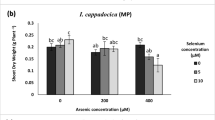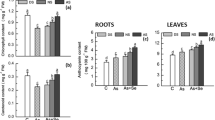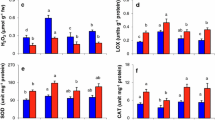Abstract
The current study was conducted to investigate the role of sulfur (S) and reduced glutathione (GSH) in mitigating arsenic (As) toxicity in Isatis cappadocica and Erysimum allionii. These plants were exposed for 3 weeks to different concentrations (0, 400 and 800 μM) of As to measure fresh weight, total chlorophyll, proline and hydrogen peroxide (H2O2) content, As and S accumulation, and guaiacol peroxidase (POD) and glutathione S-transferase (GST) along with the supplementation of 20 mg L−1 of S and 500 μM of GSH. Results revealed the significant reduction of fresh weight (especially in E. allionii), activities of POD and GST enzymes and proline content as compare to control. However, the application of S and GSH enhanced the fresh weight. Inhibition in H2O2 accumulation and improvement in antioxidant responses were measured with the application of S and GSH. Hence, the supplementation of S and GSH enhanced fresh weight and total chlorophyll in both I. cappadocica and E. allionii by alleviating the adverse effects of As stress via decreased H2O2 content and restricted As uptake.









Similar content being viewed by others
Availability of data and materials
The datasets used and/or analyzed during the current study are available from the corresponding author on reasonable request.
References
Bates LS, Walderd RP, Teare ID (1973) Rapid determination of free proline for water stress studies. Plant Soil 39:205–208
Bradford MM (1976) A rapid and sensitive method for the quantitation of microgram quantities of protein utilizing the principles of protein-dye binding. Anal Biochem 72:248–254
Chan KX, Phua SU, Breusegem FV (2019) Secondary sulfur metabolism in cellular signalling and oxidative stress responses. J Exp Bot 70(16):4237–4250
Chance B, Maehly AC (1995) Assay of catalase and peroxidase. Methods Enzymol 11:764–775
Chandrakar V, Dubey A, Keshavkant S (2018) Modulation of arsenic-induced oxidative stress and protein metabolism by diphenyleneiodonium, 24-epibrassinolide and proline in Glycine max L. Acta Bota Croat 77(1):51–61
Chen TB, Wei CY, Huang ZC, Huang QF, Lu QG, Fan ZL (2002) Arsenic hyperaccumulator Pteris vittata L. and its arsenic accumulation. Chin Sci Bull 47:902–905
Dalton DA, Boniface C, Turner Z, Lindahl A, Kim HJ, Jelinek L, Govindarajulu M, Finger RE, Taylor CG (2009) Physiological roles of glutathione S-transferases in soybean root nodules. Plant Physiol 150:521–530
Dixit G, Singh AP, Kumar A, Dwivedi S, Deeba F, Kumar S, Suman S, Adhikari B, Shukla Y, Trivedi PK, Pandey V, Tripathi RD (2015) Sulfur alleviates arsenic toxicity by reducing its accumulation and modulating proteome, amino acids and thiol metabolism in rice leaves. Sci Rep 5:16205
Dmitriev AA, Krasnov GS, Rozhmina TA, Kishlyan NV, Zyablitsin AV, Sadritdinova AF, Snezhkina AV, Fedorova MS, Yurkevich OY, Muravenko OV, Bolsheva NL, Kudryavtseva AV, Melnikova NV (2016) Glutathione S-transferases and UDP-glycosyltransferases Are Involved in Response to Aluminum Stress in Flax. Front Plant Sci 7:1920
Farooq MA, Niazi AK, Akhtar J, Farooq M, Souri Z, Karimi N, Rengel Z (2019) Acquiring control: The evolution of ROS-Induced oxidative stress and redox signaling pathways in plant stress responses. Plant Physiol Biochem 141:353–369
Hasanuzzaman M, Nahar K, Anee TI, Fujita M (2017) Glutathione in plants: biosynthesis and physiological role in environmental stress tolerance. Physiol Mol Biol Plants 23(2):249–268
Hu ZY, Zhu YG, Li M, Zhang LG, Cao ZH, Smith FA (2007) Sulfur (S)-Induced enhancement of iron plaque formation in the rhizosphere reduces arsenic accumulation in rice (Oryza sativa L.) Seedlings. Environ Pollut 147:387–393
Hussain SJ, Masood A, Anjum NA, Khan NA (2019) Sulfur-mediated control of salinity impact on photosynthesis and growth in mungbean cultivars screened for salt tolerance involves glutathione and proline metabolism, and glucose sensitivity. Acta Physiol Plant 41(8):1–13
Jung HI, Kong MS, Lee BR, Kim TH, Chae MJ, Lee EJ, Jung GB, Lee CH, Sung JK, Kim YH (2019) Exogenous Glutathione Increases Arsenic Translocation Into Shoots and Alleviates Arsenic-Induced Oxidative Stress by Sustaining Ascorbate-Glutathione Homeostasis in Rice Seedlings. Front Plant Sci 10:1089
Karalija E, Selović A (2018) The effect of hydro and proline seed priming on growth, proline and sugar content, and antioxidant activity of maize under cadmium stress. Environ Sci Pollut Res Int 25(33):33370–33380
Karimi N, Souri Z (2015) Effect of Phosphorus on Arsenic Accumulation and Detoxification in Arsenic Hyperaccumulator, Isatis cappadocica. J Plant Growth Regul 34:88–95
Karimi N, Souri Z (2016) Antioxidant enzymes and compounds complement each other during arsenic detoxification in shoots of Isatis cappadocica Desv. Chem Ecol 32:937–951
Karimi N, Ghaderian SM, Raab A, Feldmann J, Meharg AA (2009) An Arsenic Accumulating, Hypertolerant Brassica, Isatis cappadocica. New Phytol 184:41–47
Karimi N, Ghaderian SM, Marofi H, Schat H (2010) Analysis of Arsenic in Soil and Vegetation of a Contaminated Area in Zarshuran, Iran, Identify Two Angiosperm Arsenic Hyperaccumulators. Int J Phytoremed 12:159–173
Khademi Azam S, Karimi N, Souri Z, Vaculík M (2021) Multiple effects of silicon on alleviation of arsenic and cadmium toxicity in hyperaccumulator Isatis cappadocica Desv. Plant Physiol Biochem 168:177–187
Khan E, Gupta M (2018) Arsenic–silicon priming of rice (Oryza sativa L.) seeds influence mineral nutrient uptake and biochemical responses through modulation of Lsi-1, Lsi-2, Lsi-6 and nutrient transporter genes. Sci Rep 8:10301
Kim YO, Bae H-J, Cho E, Kang H (2017) Exogenous Glutathione Enhances Mercury Tolerance by Inhibiting Mercury Entry into Plant Cells. Front Plant Sci 8:683
Kishor PBK, Sreenivasulu N (2014) Is proline accumulationpersecorrelated with stresstolerance or is proline homeostasis a more critical issue? Plant Cell Environ 37:300–311
Kumar S, Trivedi PK (2018) Glutathione S-transferases: role in combating abiotic stresses including arsenic detoxification in plants. Front Plant Sci 9:751
Kushwaha BK, Singh VP (2019) Glutathione and hydrogen sulfide are required for sulfur-mediated mitigation of Cr (VI) toxicity in tomato, pea and brinjal seedlings. Physiol Plant 168:406–421
Lee BR, Muneer S, Park SH, Zhang Q, Kim TH (2013) Ammoniuminduced proline and sucrose accumulation, and their signifcance in antioxidative activity and osmotic adjustment. Acta Physiol Plant 35:2655–2664
Li X-W, Lei M, Chen T-B, Wan X-M (2009) Roles of Sulfur in the Arsenic Tolerant Plant Adiantum capillus-veneris and the Hyperaccumulator Pteris vittata. J Korean Soc Appl Biol Chem 52:498–502
Liang X, Zhang L, Natarajan SK, Becker DF (2013) Proline mechanisms of stress survival. Antioxid Redox Signal 19(9):998–1011
Lichtenthaler HK (1987) Chlorophylls and carotenoids: pigments of photosynthetic biomembranes. Methods Enzymol 148:350–382
Lu Y, Wang Q-F, Li J, Xiong J, Zhou L-N, He S-L (2019) Effects of exogenous sulfur on alleviating cadmium stress in tartary buckwheat. Sci Rep 9(1):1–12
Mallick S, Kumar N, Singh AP, Sinam G, Yadav RN, Sinha S (2013a) Role of Sulfate in Detoxification of Arsenate-Induced Toxicity in Zea mays L. (SRHM 445): Nutrient Status and Antioxidants. J Plant Interact 2:140–154
Mallick S, Kumar N, Singh AP, Sinam G, Yadav RN, Sinhautrient S (2013b) Role of sulfate in detoxification of arsenate-induced toxicity in Zea mays L. (SRHM 445): nutrient status and antioxidants. J Plant Interact 8:140–154
Meharg AA, Hartley-Whitaker J (2002) Arsenic Uptake and Metabolism in Arsenic Resistant and Nonresistant Plant Species. New Phytol 154:29–43
Noctor G, Mhamdi A, Chaouch S, Han Y, Neukermans J, Marquez-Garcia B, Queval G, Foyer CH (2012) Glutathione in plants: An Integrated Overview. Plant Cell Environ 35:454–484
Patra M, Bhowmik N, Bandopadhyay B, Sharma A (2004) Comparison of mercury, lead and arsenic with respect to genotoxic effects on plant systems and the development of genetic tolerance. Environ Exp Bot 52:199–223
Praveen A, Gupta M (2018) Nitric oxide confronts arsenic stimulated oxidative stress and root architecture through distinct gene expression of auxin transporters,nutrient related genes and modulates biochemical responses in Oryza sativa L. Environ Pollut 240:950–962
Rais L, Masood A, Inam A, Khan N (2013) Sulfur and nitrogen coordinately improve photosynthetic efciency, growth and proline accumulation in two cultivars of mustard under salt stress. J Plant Biochem Physiol 1:1
Rohman MM, Hossain MD, Suzuki T, Takada G, Fujita M (2009) Quercetin-4'-glucoside: a physiological inhibitor of the activities of dominant glutathione S-transferases in onion (Allium cepa L.) bulb. Acta Physiol Plant 31:301–309
Roychoudhury A, Basu S (2012) Ascorbate-Glutathione and Plant Tolerance to Various Abiotic Stresses. In: Anjum NA, Umar S, Ahmad A (eds) Oxidative stress in plants: Causes, consequences and tolerance. IK International Publishers, New Delhi, pp 177–258
Sahay S, Khan E, Praveen A, Panthri M, Mirza Z, Gupta M (2020) Sulphur potentiates selenium to alleviate arsenic-induced stress by modulating oxidative stress, accumulation and thiol-ascorbate metabolism in Brassica juncea L. Environ Sci Pollut Res Int 27(11):11697–11713
Selim S, Abuelsoud W, Al-Sanea MM, AbdElgawad H (2021) Elevated CO2 differently suppresses the arsenic oxide nanoparticles-induced stress in C3 (Hordeum vulgare) and C4 (Zea maize) plants via altered homeostasis in metabolites specifically proline and anthocyanin metabolism. Plant Physiol Biochem 166:235–245
Shri M, Kumar S, Chakrabarty D, Trivedi PK, Mallick S, Misra P, Shukla D, Mishra S, Srivastava S, Tripathi RD, Tuli R (2009) Effect of Arsenic on Growth, Oxidative Stress, and Antioxidant System in Rice Seedlings. Ecotoxicol Environ Saf 72:1102–1110
Singh R, Parihar P, Prasad SM (2020) Sulphur and calcium attenuate arsenic toxicity in Brassica by adjusting ascorbate–glutathione cycle and sulphur metabolism. Plant Growth Regul 91(2):221–235
Smith SE, Christophersen HM, Pope S, Smith FA (2010) Arsenic Uptake and Toxicity in Plants: Integrating Mycorrhizal Influences. Plant Soil 327:1–21
Souri Z, Karimi N (2017) Enhanced Phytoextraction by As Hyperaccumulator Isatis cappadocica Spiked with Sodium Nitroprusside. Soil Sediment Contamin: An Intl J 26:457–468
Souri Z, Karimi N, Sandalio LM (2017a) Arsenic Hyperaccumulation Strategies: An Overview. Front Cell Dev Biol 5:67
Souri Z, Karimi N, Sarmadi M, Rostami E (2017b) Salicylic acid nanoparticle (SANPs) improve growth and phytoremediation efficiency of Isatis cappadocica Desv. under arsenic stress. IET Nanobiotechnol 11(6):650–655
Souri Z, Karimi N, de Oliveira LM (2018) Antioxidant enzymes responses in shoots of arsenic hyperaccumulator, Isatis cappadocica Desv., under interaction of arsenate and phosphate. Environ Technol 39(10):1316–1327
Souri Z, Cardoso AA, da Silva CJ, Oliveira LM, Dari B, Sihi D, Karimi N (2019) Heavy metals and photosynthesis: recent developments. Photosynth Product Environ Stress pp:107–134.
Souri Z, Karimi N, Farooq MA, Sandalio LM (2020) Nitric oxide improves tolerance to arsenic stress in Isatis cappadocica desv Shoots by enhancing antioxidant defenses. Chemosphere 239:124523
Souri Z, Karimi N, Ahmad P (2021a) The effect of NADPH oxidase inhibitor diphenyleneiodonium (DPI) and glutathione (GSH) on Isatis cappadocica, under Arsenic (As) toxicity. Int J Phytoremed 23(9):945–957
Souri Z, Karimi N, Norouzi L, Ma X (2021b) Elucidating the physiological mechanisms underlying enhanced arsenic hyperaccumulation by glutathione modified superparamagnetic iron oxide nanoparticles in Isatis cappadocica. Ecotoxicol Environ Saf 206:111336
Speiser A, Silbermann M, Dong Y, Haberland S, Uslu VV, Wang S, Bangash SAK, Reichelt M, Meyer AJ, Wirtz M, Hell R (2018) Sulfur Partitioning between Glutathione and Protein Synthesis Determines Plant Growth. Hella Plant Physiol 177:927–937
Srivastava S, D’Souza SF (2010) Effect of Variable Sulfur Supply on Arsenic Tolerance and Antioxidant Responses in Hydrilla verticillata (L.f.) Royle. Ecotoxicol Environ Saf 73:1314–1322
Suman S, Adhikari B, Shukla Y, Trivedi PK, Pandey V, Tripathi RD (2015) Sulfur alleviates arsenic toxicity by reducing its accumulation and modulating proteome, amino acids and thiol metabolism in rice leaves. Sci Rep 5:16205
Tabatabai MA, Bremner JM (1970) A Simple Turbidimetric Method of Determining Total Sulfur in Plant Materials1. Agron J 62:805–806
Tripathi P, Mishra A, Dwivedi S, Chakrabarty D, Trivedi PK, Singh RP, Tripathi RD (2012) Differential response of oxidative stress and thiol metabolism in contrasting rice genotypes for arsenic tolerance. Ecotoxicol Environ Saf 79:189–198
Velikova V, Yordanov I, Edreva A (2000) Oxidative stress and some antioxidant systems in acid rain-treated bean plants. Plant Sci 151:59–66
Verdoy D, Coba De La Peña T, Redondo FJ, Lucas MM, Pueyo JJ (2006) Transgenic Medicago truncatula plants that accumulate proline display nitrogen-fxing activity with enhanced tolerance to osmotic stress. Plant Cell Environ 29(10):1913–1923
Vezza ME, Llanes A, Travaglia CN, Agostini E, Talano MA (2018) Arsenic stress effects on root water absorption in soybean plants: physiological and morphological aspects. Plant Physiol Biochem 123:8–17
Wei S, Ma LQ, Saha U, Mathews S, Sundaram S, Rathinasabapathi B, Zhou Q (2010) Sulfate and glutathione enhanced arsenic accumulation by arsenic hyperaccumulator Pteris vittata L. Environ Pollut 158:1530–1535
Yang Z, Lu W, Long Y, Bao X, Yang Q (2011) Assessment of Heavy Metals Contamination in Urban Topsoil from Changchun City, China. J Geochem Explor 108:27–38
Zhang W, Cai Y, Downum KR, Ma LQ (2004) Thiol Synthesis and Arsenic Hyperaccumulation in Pteris vittata (Chinese Brake Fern). Environ Pollut 131:337–345
Zhao FJ, Ma JF, Meharg AA, McGrath SP (2009) Arsenic Uptake and Metabolism in Plants. New Phytol 181:777–794
Zhong L, Hu C, Tan Q, Liu J, Sun X (2011) Effects of Sulfur Application on Sulfur and Arsenic Absorption by Rapeseed in Arsenic Contaminated Soil. Plant Soil Environ 57:429–434
Acknowledgments
We thank Dr. Parvaiz Ahmad (Department of Botany, S.P. College, Srinagar, 190001, Jammu and Kashmir, India) for the improvement in this paper.
Funding
This work was not supported by any institute.
Author information
Authors and Affiliations
Contributions
Naser Karimi, designed the experiment, supervised the project and wrote the manuscript. Mitra Arianmehr performed the experiment. Zahra Souri analyzed the data and modified the manuscript.
Corresponding author
Ethics declarations
Ethical Approval
This article does not contain any studies with human participants or animals performed by any of the authors.
Consent to Participate
Not applicable.
Consent to Publish
Not applicable.
Competing Interests
The authors declare that they have no known competing financial interests or personal relationships that could have appeared to influence the work reported in this paper.
Conflict of interest
The authors declare that they have no conflict of interest.
Additional information
Responsible Editor: Gangrong Shi
Publisher’s note
Springer Nature remains neutral with regard to jurisdictional claims in published maps and institutional affiliations.
Rights and permissions
About this article
Cite this article
Arianmehr, M., Karimi, N. & Souri, Z. Exogenous supplementation of Sulfur (S) and Reduced Glutathione (GSH) Alleviates Arsenic Toxicity in Shoots of Isatis cappadocica Desv and Erysimum allionii L. Environ Sci Pollut Res 29, 64205–64214 (2022). https://doi.org/10.1007/s11356-022-19477-4
Received:
Accepted:
Published:
Issue Date:
DOI: https://doi.org/10.1007/s11356-022-19477-4




